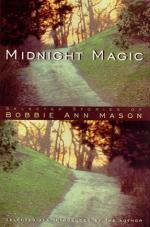|
This section contains 4,444 words (approx. 15 pages at 300 words per page) |

|
SOURCE: Fine, Laura. “Going Nowhere Slow: The Post-South World of Bobbie Ann Mason.” Southern Literary Journal 32, no. 1 (fall 1999): 87–97.
In the following essay, Fine argues that Mason's depiction of the South in her short fiction lacks the traditional values found in the stories of other southern writers such as Flannery O'Connor.
In his 1930 story “A Rose for Emily” William Faulkner depicts a South in painful transition. The Old South, with its history of slavery, racism, and cruelty masked by a genteel front, battles the forces of the New South, mercantile, unconcerned with beauty. In Flannery O'Connor's stories, the South is peopled by shallow, narrow-minded whites, representatives of both the New and Old South, who assume a superiority based on their race while demonstrating a gaping ignorance of their shortcomings. O'Connor uses her bladelike humor to teach her smug characters important lessons, the ultimate being that the world is ordered...
|
This section contains 4,444 words (approx. 15 pages at 300 words per page) |

|


